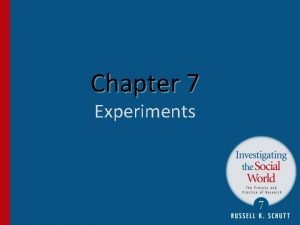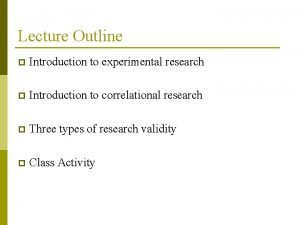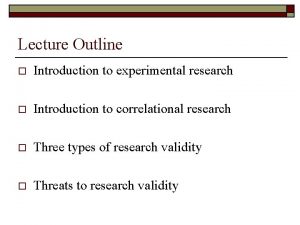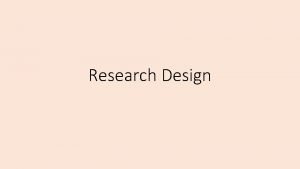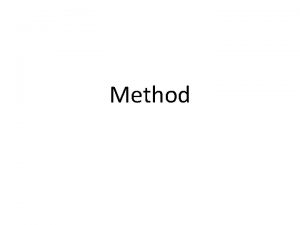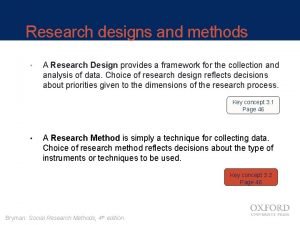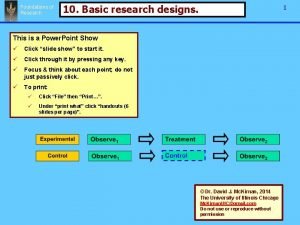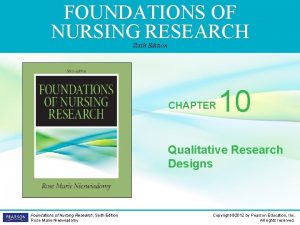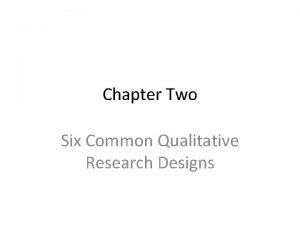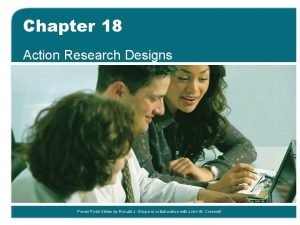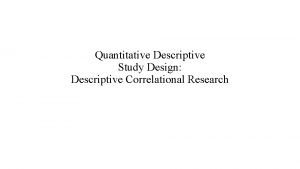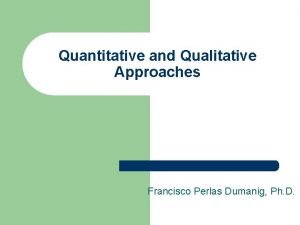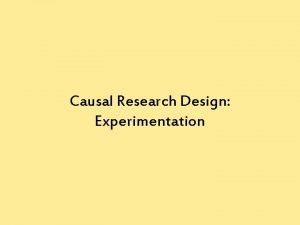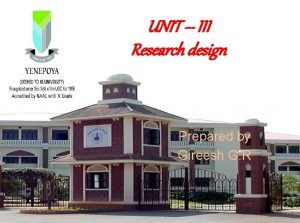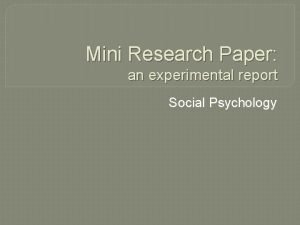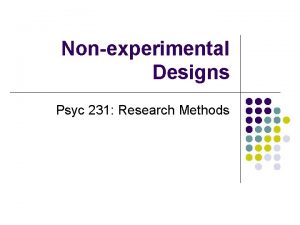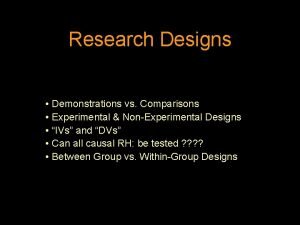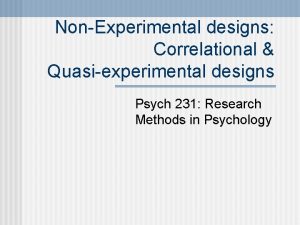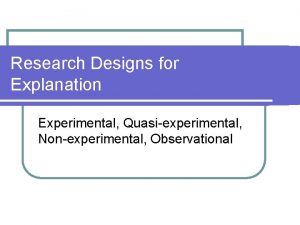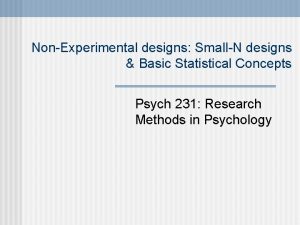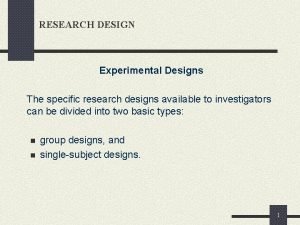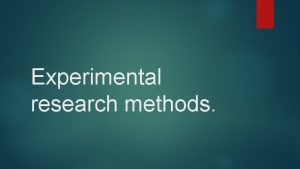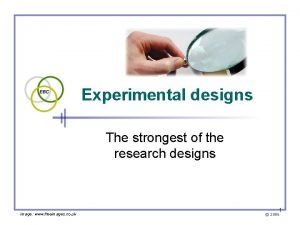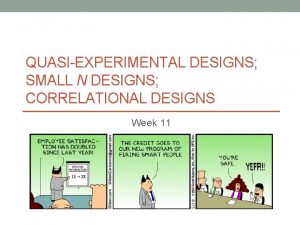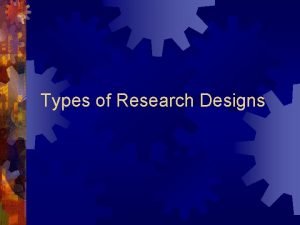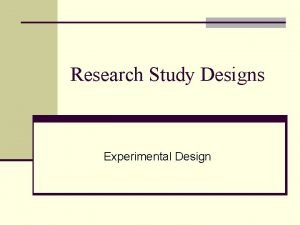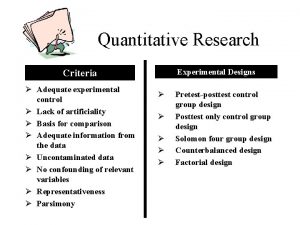Nonexperimental designs Outline 1 Experimental vs nonexperimental research



































- Slides: 35

Non-experimental designs

Outline 1. Experimental vs. non-experimental research 2. Four kinds of non-experimental research: – – Observational research Archival research Case studies Surveys

1. Experimental vs. non-experimental research • Experimental research requires exerting control. • Experimenters exert control through manipulation and assignment

1. Experimental vs. non-experimental research • Manipulation • researcher systematically varies conditions under which participants perform task • “treatments”

1. Experimental vs. non-experimental research • Manipulation • Assignment • researcher decides who gets which treatment

1. Experimental and non-experimental research compared • Non-experimental research allows researcher much less control • No assignment • In many cases, no manipulation

1. Experimental and non-experimental research compared • Four approaches: – Observational • Recording ongoing behavior without trying to influence it.

1. Experimental and non-experimental research compared • Four approaches: – Observational – Archival • Testing a hypothesis using data that the researcher did not collect

1. Experimental and non-experimental research compared • Four approaches: – Observational – Archival – Case study • Researcher carries out very detailed examination of individual cases

Experimental and non-experimental research compared • Four approaches: – Observational – Archival – Case study – Survey • Researcher collects information on beliefs, attitudes, preferences, behaviors, and their correlations.

Observational Research • The researcher observes behavior without influencing it. • Goals: – to describe behavior as it naturally occurs

Observational Research • The researcher observes behavior without influencing it. • Goals: – to describe behavior as it naturally occurs – to assess relationships among variables present

Observational Research • Four approaches to nonexperimental research: – Observational – Archival – Case study – Survey • Four approaches to observation: i. Naturalistic observation ii. Participant-observer research iii. Structured observation iv. Field experiments

Observational Naturalistic Archival Participantobserver Case Study Structured observation Survey Field experiments

Naturalistic Observation • Observing phenomena that cannot be created in lab, for practical or ethical reasons • Effects can be observed when such events occur naturally

Naturalistic Observation • Physical trace measures – e. g. , how “well-thumbed” is a book? – Where do paths through the snow go? • Reactivity – subjects react to the presence of the observer

Naturalistic Observation • Example: effect of early childhood isolation on later psychological development. • We can’t isolate children to study them • But we can use naturalistic observation when we discover such cases

Naturalistic observation • Candland (1993) – descriptions of feral children (raised outside human cultures) • Curtiss (1977) case studies of children subjected to unusual isolation by parents (e. g. , Genie) • Spitz (1965) – observation of institutionalized children – Showed effects of deprivation of stimulation during infancy and early childhood

Observational Research • Four approaches to observation: i. Naturalistic observation ii. Participant-observer research iii. Structured observation iv. Field experiments

Participant-observer research • Observer joins a group for the purpose of studying group members • Undisguised vs. disguised • Why use disguised observation? – Access to behavior and situations

Participant-observer research • Observer joins a group for the purpose of studying group members • Potential cost to objectivity – Stockholm syndrome

Observational Research • Four approaches to observation: i. Naturalistic observation ii. Participant-observer research iii. Structured observation iv. Field experiments

Structured observation • Researcher exerts some control – Eleanor Gibson’s visual cliff studies – Piaget’s studies • Replication depends upon following exactly the same procedures

Observational Research • Four approaches to observation: i. Naturalistic observation ii. Participant-observer research iii. Structured observation iv. Field experiments

Field experiments • Researcher manipulates one or more variables in a natural setting to determine effect on behavior • One end of the intervention – nonintervention continuum

Field experiments example • Crusco & Wetzel (1984) • effect of touching on restaurant customers • waitresses worked as confederates • tip amount was dependent variable

Field experiments example • Crusco & Wetzel (1984) • Compared No Touch condition with Fleeting Touch and Shoulder Touch conditions • Men tipped more than women • Both men and women tipped more after being touched at some point during their meal.

Observational Research • Four approaches to nonexperimental research: – Observational – Archival – Case study – Survey • Testing a hypothesis using data that the researcher did not collect

b. Archival Research • Archival records are a rich source of data – No possibility of reactivity – Often very inexpensive approach • • • Government files Corporations Universities Newspapers Google cache Internet wayback machine

b. Archival Research – an example • Lau & Russell (1980) – Tested external validity of laboratory findings on causal attributions • People make internal attributions for success and external attributions for failure

Lau & Russell (1980) • Sports pages in 8 daily newspapers • Found 594 explanations for success and failure involving 33 sports events • Proportions of internal attributions: • success – 75% • failure – 45%

Case Studies • Intensive studies of individual cases. – Strength: you learn a lot about the case studied – Weakness: results may not generalize • We’ll come back to this topic when we look at Single-Subject Experiments.

Surveys - Definition • A procedure for systematically collecting data on attitudes, preferences, knowledge, or behavior by asking people questions. • The answers provide information about the group(s) that those people represent.

d. Surveys • Use surveys when: – You want data regarding a large group of people (a population) – Measuring whole population is too expensive in time, money or other resources • Population = all the cases of interest

Surveys • We’ll look at surveys in greater detail in the next lecture…
 Experimental vs non experimental
Experimental vs non experimental Quasi-experimental research designs
Quasi-experimental research designs Quasi-experimental research designs
Quasi-experimental research designs Disadvantages of experimental research
Disadvantages of experimental research Experimental research outline
Experimental research outline Operational definition psych
Operational definition psych Experimental vs non experimental
Experimental vs non experimental 11 principles of design
11 principles of design Completely randomized experimental design
Completely randomized experimental design Design research meaning
Design research meaning Basic principles of experimental designs
Basic principles of experimental designs Research instrument in experimental research
Research instrument in experimental research Research instrument in experimental research
Research instrument in experimental research Experimental vs non experimental
Experimental vs non experimental Univariate descriptive design
Univariate descriptive design Findings of qualitative research
Findings of qualitative research Different types of research designs
Different types of research designs Basic research designs
Basic research designs Chapter 10 qualitative research designs book
Chapter 10 qualitative research designs book Types of qualitative designs
Types of qualitative designs Types of action research design
Types of action research design Types of quantitative research designs
Types of quantitative research designs Disadvantage of quasi experimental design
Disadvantage of quasi experimental design Correlational research quantitative
Correlational research quantitative Analyzing and interpreting data in research
Analyzing and interpreting data in research Exploratory, descriptive and causal research
Exploratory, descriptive and causal research Research design causal
Research design causal Exploratory descriptive design
Exploratory descriptive design Chapter 10 qualitative data analysis
Chapter 10 qualitative data analysis Types of research design exploratory
Types of research design exploratory Research designs
Research designs Marketing research designs
Marketing research designs Characteristics of experimental research design
Characteristics of experimental research design Example of experiment research
Example of experiment research Experimental research chapter 2
Experimental research chapter 2 Example of mini research
Example of mini research


